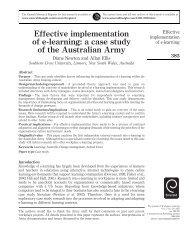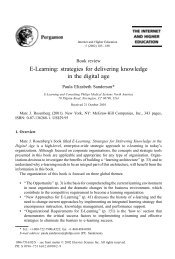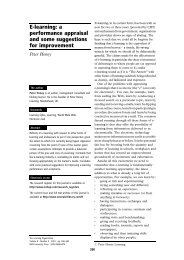Designing E-learning Interactions in the 21st Century: revisiting and ...
Designing E-learning Interactions in the 21st Century: revisiting and ...
Designing E-learning Interactions in the 21st Century: revisiting and ...
Create successful ePaper yourself
Turn your PDF publications into a flip-book with our unique Google optimized e-Paper software.
Andrew Ravenscroft 153<br />
HARTLEY, J.R. (1998) Qualitative reason<strong>in</strong>g <strong>and</strong> conceptual change: computer<br />
based support <strong>in</strong> underst<strong>and</strong><strong>in</strong>g science, <strong>in</strong>: WINKELS, R.G.F. & BREDEWEG, B.<br />
(Guest Eds) Interactive Learn<strong>in</strong>g Environments. Special Issue on The Use of<br />
Qualitative Reason<strong>in</strong>g Techniques <strong>in</strong> Interactive Learn<strong>in</strong>g Environments, 5, pp.<br />
53±64.<br />
HARTLEY, J. R., BYARD, M. & MALLEN, C. L. (1991) Qualitative model<strong>in</strong>g <strong>and</strong><br />
conceptual change <strong>in</strong> science students, <strong>in</strong>: L. BIRNBAUM (Ed) The<br />
International Conference on <strong>the</strong> Learn<strong>in</strong>g Sciences, Proceed<strong>in</strong>gs of <strong>the</strong> 1991<br />
Conference, Northwestern University of Evanston, Ill<strong>in</strong>ois, Charlottesville,<br />
Virg<strong>in</strong>a.<br />
HARTLEY, J, R. & RAVENSCROFT, A. (1999) Support<strong>in</strong>g exploratory <strong>and</strong> expressive<br />
<strong>learn<strong>in</strong>g</strong>: a complimentary approach, <strong>in</strong>: DICHEVA, D. & KOMMERS, P. A. M.<br />
(Guest Eds) International Journal of Cont<strong>in</strong>u<strong>in</strong>g Eng<strong>in</strong>eer<strong>in</strong>g Education <strong>and</strong><br />
Lifelong Learn<strong>in</strong>g. Special Issue: Micro Worlds for Education <strong>and</strong> Cont<strong>in</strong>uous<br />
Learn<strong>in</strong>g, 9, pp. 275±291.<br />
HAYES, P. J. (1985) The second naive physics manifesto, <strong>in</strong>: HOBBS, J. R. & MOORE,<br />
R. C. (Eds) Formal Theories of <strong>the</strong> Commonsense World (New Jersey, Ablex).<br />
HOYLES, C. & NOSS, R. (1992) A pedagogy for ma<strong>the</strong>matical microworlds,<br />
Educational Studies <strong>in</strong> Ma<strong>the</strong>matics, 23, pp. 31±57.<br />
ISROFF, K. & SCANLON, E. (2001) Case studies revisited: what can Activity Theory<br />
offer? Proceed<strong>in</strong>gs of International Conference on Computer Supported<br />
Collaborative Learn<strong>in</strong>g 2001 (CSCL 2001), Maastricht, 22±24 March 2001.<br />
KATZ, S. (1997) Peer <strong>and</strong> student-mentor <strong>in</strong>teraction <strong>in</strong> a computer-based tra<strong>in</strong><strong>in</strong>g<br />
environment for electronic fault diagnosis (Technical Report) (Pittsburgh,<br />
PA, Learn<strong>in</strong>g Research <strong>and</strong> Development Center).<br />
KNUTTI, K. (1996) Activity <strong>the</strong>ory as a potential framework for human-computer<br />
<strong>in</strong>teraction research, <strong>in</strong>: NARDI, B. (Ed) Context <strong>and</strong> Consciousness: activity<br />
<strong>the</strong>ory <strong>and</strong> human-computer <strong>in</strong>teraction (Cambridge, MIT Press).<br />
KUHN, D., SHAW, V. & FELTON, M. (1997) Effects of dyadic <strong>in</strong>teraction on<br />
argumentative reason<strong>in</strong>g, Cognition <strong>and</strong> Instruction, 15, pp. 287±315.<br />
LAURILLARD, D. (1993) Reth<strong>in</strong>k<strong>in</strong>g University Teach<strong>in</strong>g: a framework for <strong>the</strong><br />
effective use of educational technology (London <strong>and</strong> New York, Routledge).<br />
LEVIN, J.A. & MOORE, J.A. (1977) Dialogue-Games: Metacommunication<br />
Structures for Natural Language Interaction. Cognitive Science, 1, pp. 395±<br />
420.<br />
LEWIS, R. (1997) An activity <strong>the</strong>ory framework to explore distributed<br />
communities, Journal of Computer Assisted Learn<strong>in</strong>g, 13, pp. 210±218.<br />
LITTLETON, K. & LIGHT, P. (Eds) (1998) Learn<strong>in</strong>g with Computers: analys<strong>in</strong>g<br />
productive <strong>in</strong>teractions (London, Routledge).<br />
MACKENZIE, J. D. (1979) Question-begg<strong>in</strong>g <strong>in</strong> non-cummulative systems, Journal<br />
of Philosophical Logic, 8, pp. 117±133.<br />
MATHESON, M. & RAVENSCROFT, A. (2001) Evaluat<strong>in</strong>g <strong>and</strong> <strong>in</strong>vestigat<strong>in</strong>g <strong>learn<strong>in</strong>g</strong><br />
through collaborative argumentation, Dialogue & Design Research Group<br />
Technical Report DDRG-01-01, The Open University, UK.<br />
MAUDET, N. & EVRARD, F. (1998) A generic framework for dialogue game<br />
implementation, <strong>in</strong>: HULSTIJN, J. & NIJHOLT, A. (Eds) Second Workshop on<br />
Formal Semantic <strong>and</strong> Pragmatics of Dialogue (TWLT13) May 13±15, 1998,<br />
University of Twente,<br />
MAUDET, N. & MOORE, D. J. (2000) Dialogue games as dialogue models for<br />
ß Blackwell Publishers Ltd 2001
















